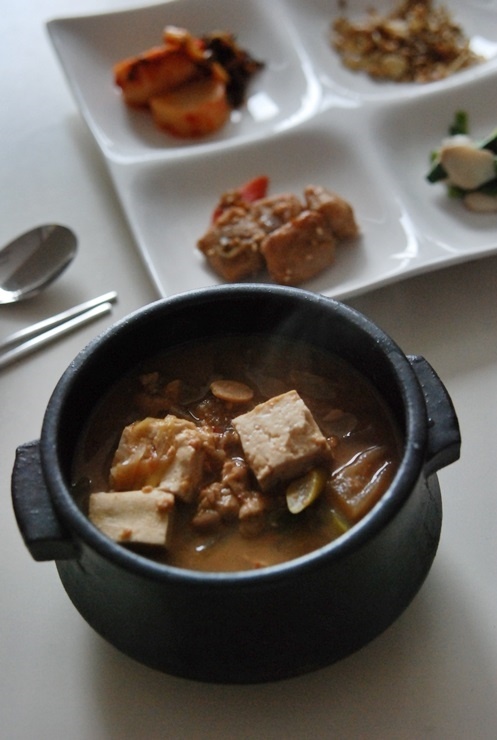Rich and Savory Cheonggukjang Stew
Follow the ‘Golden Recipe’ from Saengsaengjeongbotong: Making Delicious and Aromatic Cheonggukjang Stew

When you’re wondering what to cook, a warm, hearty soup often comes to mind, right? While doenjang jjigae (soybean paste stew) or kimchi jjigae are great options, a single pot of deeply flavorful and savory cheonggukjang jjigae (fermented soybean paste stew) is perfect for finishing off a bowl of rice. It’s also wonderful for mixing with leftover seasoned vegetables, and it’s a fantastic ‘rice thief’ all on its own. I recently saw the ‘golden recipe’ for cheonggukjang featured on Saengsaengjeongbotong, and it seemed quite similar to how I usually make it! Shall we try making cheonggukjang stew even more delicious by following that secret method?
Stew Ingredients- 250g Cheonggukjang (fermented soybean paste)
- 1/3 cup well-fermented kimchi
- 1 segment green onion
- 1/2 block firm tofu
- 1/3 onion
- 1/2 piece daikon radish (approx. 2cm thick)
- 4cm length zucchini
- 5 cups Cheonggukjang broth
Broth Ingredients (Using what you have)- 7 cups water
- 1/3 onion
- 20 dried shrimp
- 7 dried anchovies (for broth)
- 1/4 tbsp chili seeds
- 1/2 green onion root
- 2 sheets dried kelp (dashima)
- 1 dried pollack head
- 1 dried shiitake mushroom
- 1/2 piece daikon radish (approx. 2cm thick)
- 7 cups water
- 1/3 onion
- 20 dried shrimp
- 7 dried anchovies (for broth)
- 1/4 tbsp chili seeds
- 1/2 green onion root
- 2 sheets dried kelp (dashima)
- 1 dried pollack head
- 1 dried shiitake mushroom
- 1/2 piece daikon radish (approx. 2cm thick)
Cooking Instructions
Step 1
First, let’s prepare the broth that adds a deep flavor to the cheonggukjang stew. While it would be ideal to make the broth according to the Saengsaengjeongbotong recipe, I had some broth already made and stored in the refrigerator, so I’m using that. If you have pre-made broth, feel free to use it, or if not, try making it with the broth ingredients listed below.

Step 2
Now, introducing the key ingredients for the cheonggukjang stew! The Saengsaengjeongbotong ‘golden recipe’ emphasizes not only the freshness of the ingredients but also that the order of adding them and the heat level are crucial for the taste. The ingredients for today are: 1/3 cup well-fermented kimchi, 1 segment green onion, 1/2 block firm tofu, 1/3 onion, 1/2 piece daikon radish (approx. 2cm thick), and a 4cm length of zucchini. Let’s make a delicious cheonggukjang stew with these ingredients!

Step 3
Prepare each ingredient appropriately for the stew. Slice the daikon radish thinly into bite-sized pieces (about 0.5cm thick). Chop the kimchi into manageable pieces (about 1cm). Dice the onion similarly to the daikon radish (about 1cm).

Step 4
Slice the zucchini into fan shapes, about 0.5cm thick. Cut the tofu into rectangular slices, about 1.5cm thick. Slice the green onion diagonally to add its aroma.

Step 5
Now it’s time to cook the ingredients in the pot. Pour 5 cups of the prepared broth into the pot, and add the sliced daikon radish and chopped kimchi. Simmer over medium heat for about 5 minutes, until the radish becomes translucent and the kimchi softens. This step helps deepen the flavor of the broth.

Step 6
Once the daikon radish and kimchi are somewhat cooked, add the sliced zucchini and onion. Bring to a boil over high heat and cook for another 5 minutes. Boiling over high heat allows the fresh flavors of the vegetables to infuse well into the broth.

Step 7
Now it’s time to add the star ingredient – the cheonggukjang! Cheonggukjang can become bitter if boiled for too long, so it’s crucial to add it at the very end and simmer for precisely 3 minutes. Five stars for this tip! Add 250g of cheonggukjang and let it bubble vigorously over high heat for 3 minutes to bring out its natural savory flavor.

Step 8
After 3 minutes, finally add the diagonally sliced green onion and the tofu slices. Let it simmer briefly and then immediately turn off the heat. Gently stir to prevent the tofu from breaking. Enjoy your warm and savory cheonggukjang stew! It’s absolutely delicious when mixed with rice.




